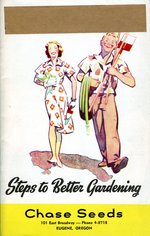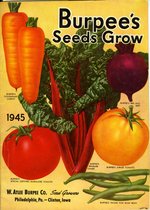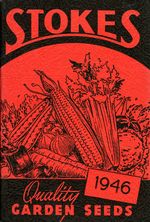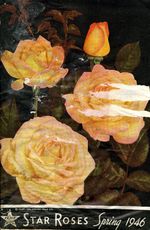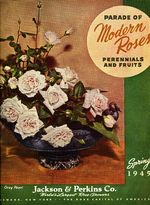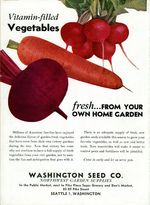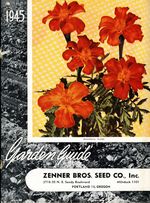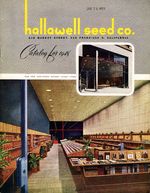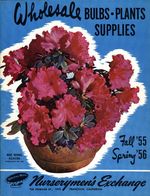“In one respect at least austerity has disappeared from the face of Britain. Our land is lovely once again with flowers…”
Perry's Hardy Plant Farm front inside cover, 1948
With few exceptions, most catalogues in the OSU collection from after 1945 are from the United States. They celebrated the end of the war with exuberant colorful flower pictures, and exhortations to settle down and grow more flowers to decorate “home sweet home”. According to an article on Burpee Seeds’ website, the company concluded that the government might object if they depicted a victory sign on the cover of its 1945 catalogue. Instead, they decided to send their readers a subliminal victory message with a V-shaped red Swiss chard plant, surrounded by carrot “bombs” over a globe-shaped tomato.1 Catalogues welcomed back returned servicemen as in Stokes’ catalogue of 1946. Varieties were given historically relevant names: The back cover of Jackson & Perkins’ 1945 catalogue features the Colossal Viola “Purple Heart”. Conard & Pyle’s catalogues of 1946-1948 explain that they renamed the French rose ‘Mme. A. Meilland’ the ‘Peace’ rose to commemorate the founding of the United Nations.
Immediately after the war, some American vegetable seed catalogues cautioned gardeners that vegetable growing was still of paramount importance, in case hostilities broke out again, or to help feed our allies. Indeed, American produce and seeds were being exported around the world for this purpose. By the late 1940s, many retail catalogues were able to promote new varieties. In 1947, Burpee featured new F1 hybrid vegetables on the back cover of its seed catalogue. In 1948, Stokes Seeds stated, “Hybrid varieties of sweet corn are now recognized as the most profitable ones to grow”. Late 1940s seed catalogues also offered many new varieties of colorful annual bedding flowers such as marigolds and petunias. Wholesale flower seed companies such as Bodger, Waller-Franklin and Sakata, listed many new hybrids of annual flowers and All-America winners. The Van Waveren catalogue of 1949 celebrated the return of pre-war bulb production levels, McLean Bulb Farms in Elma, Washington announced in 1948 that bulbs could be imported again, and the Chase of Oregon catalogue of 1947 included a map and statistics on the recent growth of bulb production in the Pacific Northwest.
Garden centers became more widespread in the 1940s-1960s, as retailers devised ways to attract customers throughout the year. According to an article in American Nurseryman magazine, Hallawell’s of San Francisco “was the forerunner of a new concept: the full-line garden center”.2 Its catalogue cover of 1948 depicts its sleek, modern store with its 60-foot seed rack, “probably the largest as well as the most unique packet fixture in the world”. From the 1950s, the OSU collection contains more wholesale catalogues of plants and supplies for nurseries and garden centers, several of which are scanned here.
Notes
- See http://www.burpee.com/gardening/content/the-legacy-of-w.-atlee-burpee/legacy.html
- Jack Schreider, “Retailing Renaissance”, American Nurseryman, June 15, 1990:66

